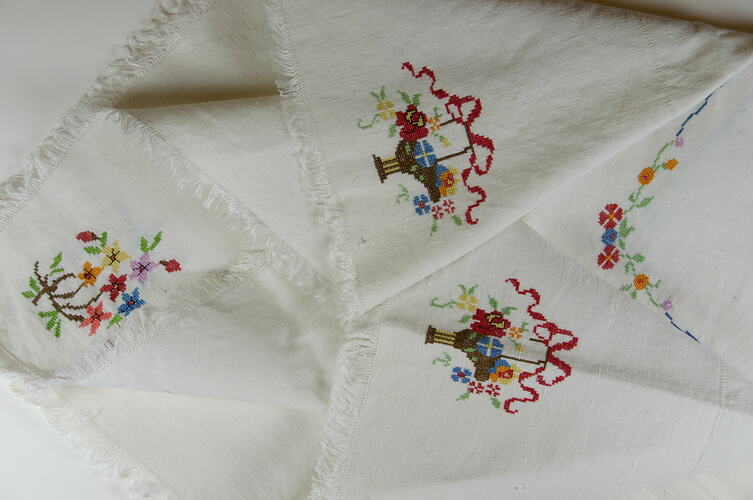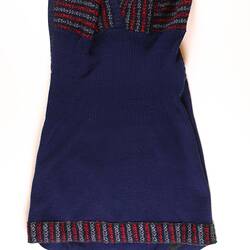Summary
Supper Cloth purchased in Italy for Edda Azzola's glory box by her mother, and hand embroidered by Edda. Edda Azzola, nee Pugnetti, was born in 1927 in Moggio Udinese in the Friuli region, northern Italy and the family moved to nearby Pontebba four years later. After their early schooling, Edda and her two sisters worked as knitting machinists from the family home. The income they made was saved by their mother who used the money to purchase items for their dowries. Edda's dowry included 6 pairs of double linen sheets which she embroidered, 12 towels and other items.
Edda married Angelo Azzola, a young man from her village. Searching for change, adventure and a better life, Edda persuaded her husband to migrate to Australia in 1954 and she followed a year later in 1955. Her glory box followed her later. The couple lived in Carlton and Fitzroy in inner Melbourne during the early years and Edda purchased an Italian knitting machine from another Italian migrant woman in Melbourne and worked as a textile factory outworker for about 20 years.
Physical Description
White cotton Supper Cloth, with fringing around the edges. It has has been hand embroidered with a floral pattern done in cross stitch in pink, red, yellow, purple, blue, red, green and brown.
Significance
The Edda Azzola knitting machine collection enables the exploration of issues relating to post World War II migration experiences, outworker working life, the post-war inner city Melbourne textile industry and dowry production. The collection, which includes a domestic knitting machine, tools, materials, textile samples, garments, a design notebook, photographs, an oral history interview, operator demonstration video and hand made glory box items, all combine to create a rich snapshot of working and migrant life, particularly significant with the large numbers of migrant women who were employed in and for textile factories around the city. This story and collection is also enriched by its close connection to the Richard Charlupksi story, for whom Edda worked and which explores the 1950s-1970s wool fashion industry.
More Information
-
Collecting Areas
-
Acquisition Information
Donation from Mrs Edda Azzola, 17 Dec 2007
-
Other Association (See Comments)
Mrs Pugnetti, Pontebba, Italy, circa 1940
Purchased By -
Other Association (See Comments)
Mrs Edda Azzola, Pontebba, Friuli, Italy, circa 1940s
Embroidered By -
User
Mrs Edda Azzola, Fitzroy, Greater Melbourne, Victoria, Australia, circa 1955
-
Classification
-
Category
-
Discipline
-
Type of item
-
Keywords
Domestic Life, Dowries, Glory Boxes, Immigration, Italian Communities, Italian Immigration, Textile Industry

